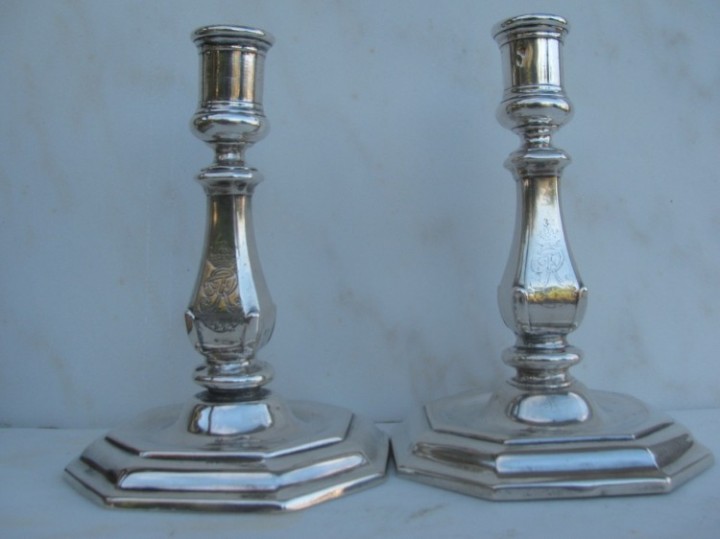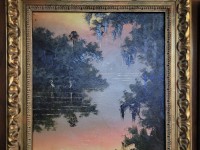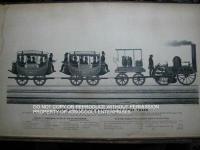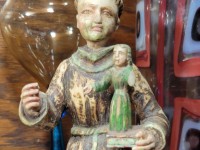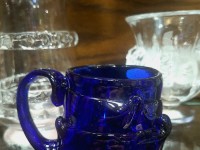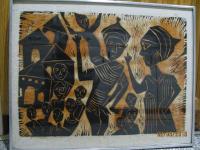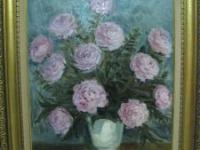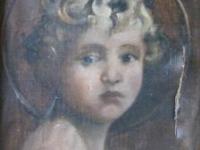Offered here and on ebay, is a pair of candlesticks from the table services of "Frederick The Great" - King of Prussia 1740-1786, commissioned circa 1740s to Royal Court Goldsmith Christian Lieberkuhn the younger (Berlin 1709-1769).
Each candlestick has engraved on the baluster stem the Royal Prussian cypher with the monogram "FR" (Fredericus Rex), and Royal crest and crown. The maker's mark "Lieberkuhn," town Hallmark, "Standing Bear" in oval (for Berlin), and Assayer's test marks are stamped in the well beneath the bases. The candlesticks stand about 5-3/4 inches tall, have a 4 inch spreading octagonal base, and together weigh approximately 14 ounces Troy.
The candlesticks have different dimensions between the columns, knops and bases, and though both were made by the same Goldsmith, it is apparent that each one is from different periods of the King's reign.
These candlesticks were used at the dinner tables of Frederick The Great, and may very well have been used at the Schloss Sanssouci Palace during the King's famous "table talks" where he entertained many notable dignitaries and guests such as Francois-Marie Arouet, better known as "Voltaire," the Enlightenment historian and philosopher among them.
Christian Lieberkuhn, the younger, used an early 18th century model for the creation of the small, individual candlesticks. It is a well known fact that Frederick The Great was personally engaged in defining the specific style and designs for his table services and that his preference was to maintain the simplicity his father, King Frederick William l, had chosen for his table services. And so the model Lieberkuhn used is George l "Early Georgian."
Candlesticks of the George l era, be they made of Silver, Brass or even Gold, appear to lack nozzles in general. I find no documentation, evidence or even an inference that Frederick The Great ever ordered nozzles to be added to the candlesticks during his reign.
Several single candlesticks of this type, also made by Christian Lieberkuhn the younger for Frederick The Great's table services, but with added nozzles have been sold at some of the major auction houses in recent times, some fetching more than $40,000.00 for a single.
Sales references:
Villa Grisebach (Berlin), July 4, 2015 - Lot No. 3345;
Christie's (King Street London), Oct. 31, 2002 - Sale 669, Lot No. 28 (See also Lot No. 29 - similar Candlesticks for Frederick Wilhelm).
Parke Bernet, New York, 20 April 1946, lot 4, (four by Lieberkühn)
Christie's, London, 16 June 1967, lot 173, (two with mark of "MÜLLER", four by Liberkühn)
Christie's, New York, 18 April 1989, lot 277 (maker's mark FW over "MÜLLER")
Christie's, New York, 21 October 1993, lot 41 (two by MÜLLER, one by Lieberkühn, and a fourth (19th century) example by Hossauer)
Literature: Wolfgang Scheffler: Berliner Goldschmiede, Berlin 1968, p. 107 (566/119i) / exh. cat., Hanau, Deutsches Goldschmiedehaus, 1985: Kaiserliches Gold und Silber. Schätze der Hohenzollern aus dem Schloß Huis Doorn, Berlin 1985, p. 73f., cat. no. 56, ill. p. 75 (H. Schadt) (similar candlestick p. 74).
As best I have been able to determine with the information available, there are less than 10 candlesticks of this type in private hands, including this pair, that were made specifically for Frederick The Great by Christian Lieberkuhn the younger.
CONDITION:
One candlestick has a very clear engraving of the royal monogram and crest. There are 2 tiny dimples on the lower section of the shaft, one just beneath the cypher and the other on the right side panel. It has light, superficial surface scratches and other faint marks from use and the shaft has a slight tilt to the right.The maker's mark is very clear, but partial. Under the bases the Assay test marks/scratches are prominent and Hallmark is very well defined with clear details. Overall, it is very fine!
The second candlesticks engraved cypher monogram and crest, display a good deal of wear. The socket has 2 small overlapping gouge marks, which may actually be test marks, and it also has some very small abrasions and superficial surface scratches overall. On the outer edge of the base are engraved remnants of the weight. The Maker's mark and town hallmark are well defined. Overall, this candlestick is in very good condition.
The Berlin town Hallmark on both pieces is represented by a figure of a standing bear in an oval and was used in Berlin after 1735, but before 1750.
Each candlestick has engraved on the baluster stem the Royal Prussian cypher with the monogram "FR" (Fredericus Rex), and Royal crest and crown. The maker's mark "Lieberkuhn," town Hallmark, "Standing Bear" in oval (for Berlin), and Assayer's test marks are stamped in the well beneath the bases. The candlesticks stand about 5-3/4 inches tall, have a 4 inch spreading octagonal base, and together weigh approximately 14 ounces Troy.
The candlesticks have different dimensions between the columns, knops and bases, and though both were made by the same Goldsmith, it is apparent that each one is from different periods of the King's reign.
These candlesticks were used at the dinner tables of Frederick The Great, and may very well have been used at the Schloss Sanssouci Palace during the King's famous "table talks" where he entertained many notable dignitaries and guests such as Francois-Marie Arouet, better known as "Voltaire," the Enlightenment historian and philosopher among them.
Christian Lieberkuhn, the younger, used an early 18th century model for the creation of the small, individual candlesticks. It is a well known fact that Frederick The Great was personally engaged in defining the specific style and designs for his table services and that his preference was to maintain the simplicity his father, King Frederick William l, had chosen for his table services. And so the model Lieberkuhn used is George l "Early Georgian."
Candlesticks of the George l era, be they made of Silver, Brass or even Gold, appear to lack nozzles in general. I find no documentation, evidence or even an inference that Frederick The Great ever ordered nozzles to be added to the candlesticks during his reign.
Several single candlesticks of this type, also made by Christian Lieberkuhn the younger for Frederick The Great's table services, but with added nozzles have been sold at some of the major auction houses in recent times, some fetching more than $40,000.00 for a single.
Sales references:
Villa Grisebach (Berlin), July 4, 2015 - Lot No. 3345;
Christie's (King Street London), Oct. 31, 2002 - Sale 669, Lot No. 28 (See also Lot No. 29 - similar Candlesticks for Frederick Wilhelm).
Parke Bernet, New York, 20 April 1946, lot 4, (four by Lieberkühn)
Christie's, London, 16 June 1967, lot 173, (two with mark of "MÜLLER", four by Liberkühn)
Christie's, New York, 18 April 1989, lot 277 (maker's mark FW over "MÜLLER")
Christie's, New York, 21 October 1993, lot 41 (two by MÜLLER, one by Lieberkühn, and a fourth (19th century) example by Hossauer)
Literature: Wolfgang Scheffler: Berliner Goldschmiede, Berlin 1968, p. 107 (566/119i) / exh. cat., Hanau, Deutsches Goldschmiedehaus, 1985: Kaiserliches Gold und Silber. Schätze der Hohenzollern aus dem Schloß Huis Doorn, Berlin 1985, p. 73f., cat. no. 56, ill. p. 75 (H. Schadt) (similar candlestick p. 74).
As best I have been able to determine with the information available, there are less than 10 candlesticks of this type in private hands, including this pair, that were made specifically for Frederick The Great by Christian Lieberkuhn the younger.
CONDITION:
One candlestick has a very clear engraving of the royal monogram and crest. There are 2 tiny dimples on the lower section of the shaft, one just beneath the cypher and the other on the right side panel. It has light, superficial surface scratches and other faint marks from use and the shaft has a slight tilt to the right.The maker's mark is very clear, but partial. Under the bases the Assay test marks/scratches are prominent and Hallmark is very well defined with clear details. Overall, it is very fine!
The second candlesticks engraved cypher monogram and crest, display a good deal of wear. The socket has 2 small overlapping gouge marks, which may actually be test marks, and it also has some very small abrasions and superficial surface scratches overall. On the outer edge of the base are engraved remnants of the weight. The Maker's mark and town hallmark are well defined. Overall, this candlestick is in very good condition.
The Berlin town Hallmark on both pieces is represented by a figure of a standing bear in an oval and was used in Berlin after 1735, but before 1750.
04093
Payment Methods




Shipping
pickup only
Return/Exchange Policy
Returns not accepted for antique items unless the condition of the item was clearly misrepresented, seller clearly failed to properly secure item in shipping which caused damages and to which buyer must provide clear and convincing evidence, buyer received wrong item than that which was purchased.
This seller makes full and express guarantee that all items listed, purchased and received will be as they are described in the listing.
Please Login or Register first before asking a question.
